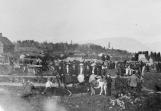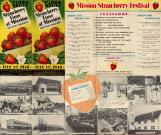16
In 1931 local residents were feeling the effects of the Depression, causing organizers to lower the price of admission to twenty-five cents. In 1932, the Fraser Valley Record was enthusiastic about the success of the fair. As the paper reported, "judging from the amount of entries and people attending, the Depression has been shelved and [is] a thing of the past." By 1940 Canada was at war once again, and the Fair Board decided to substitute war savings stamps for fifty percent of all prize money. 1948 was a year of local disaster, as Mission was hit by a major flood. That year there were special prize categories for farmers whose property had been under water for part of the growing season.Over the years the fair had its share of success and failure. It was a popular event at its conception and continued to grow throughout the first half of the twentieth century. In 1897 there were about 300 entries in the fair, and by 1922 the number had grown to 1,800. The 1946 fair was reported to be the third largest in British Columbia. The fair even attracted its share of dignitaries, being opened by Premier John Oliver in 1918 and by Premier Byron Johnson in 1950.
21
Another crowd pleaser at the Strawberry Festival was the parade. If one believes the newspaper reports, it got more spectacular every year. In 1949, for example, there was a lot of fanfare. A navy band from the HMCS Naden was to lead the parade, which would consist of dozens of brightly coloured and imaginative floats. There would also be dignitaries, school bands, and decorated bicycles. As the Fraser Valley Record said on June 8, "never in the history of Mission has such a parade been seen as the one that moved along Main Street and up to the fair grounds on Monday afternoon at the fourth annual Strawberry Festival."23
When the big day finally arrived, First Avenue was closed to traffic, and a large stage, called the Strawberry Bowl, was erected at First and Welton. The first event was the crowning of the Strawberry Queen at 1:45pm. The crowning of the strawberry queen was a major focus of the festival. Beginning in 1947 there was a strawberry king as well, but it was the queen who received most of the media attention. Four princesses had been selected: Grace Holmes, Leona Swaren, Doris Grinsted, and Bonnie Ellerbeck. Grace Holmes was chosen as queen and was given a crown of artificial strawberries. After the crowning, the other events began. There was a soapbox derby with the finish line on Main Street, and Percy Routledge was on hand with his miniature steam locomotive. There were also numerous stalls set up where people could play bingo, have their fortunes told, or participate in various other activities. There was plenty of music as well, with the Strawberry Bowl used as a venue for that sort of entertainment.24
Although the Strawberry Festival was a popular summer event, it was short lived. Ironically, the festival's demise was chiefly due to an event that had begun as one of its attractions: The Soapbox Derby. Jimmy Gunn, who was a committee member on the Board of Trade, had suggested the Soapbox Derby as a festival side event. It proved to be extremely popular, and by 1947 Mission was an official franchise of the American Soapbox Association.The Soapbox Derby attracted competitors from all over western Canada. In 1953 the race moved to the Fair Grounds, where a new track had been completed. By 1956 the Soapbox Derby had grown so much that the decision was made to cancel the Strawberry Festival altogether.
27
The Soapbox Derby outgrew Mission as well. As the list of competitors grew longer, local participation decreased. The whole affair was also quite costly; during the years of the Strawberry Festival, proceeds from the festival had been used to offset the costs of the derby. Even though sponsors helped with financing, the derby ran a large deficit. A lack of interest combined with the withdrawal of a major sponsor brought about the end of the Soapbox Derby in 1974.Thanks to the interest and hard work of many people in the community, the Soapbox Derby was revived in 1999. Hopefully their hard work will be rewarded and the Soapbox Derby will remain a popular event for many years to come.








